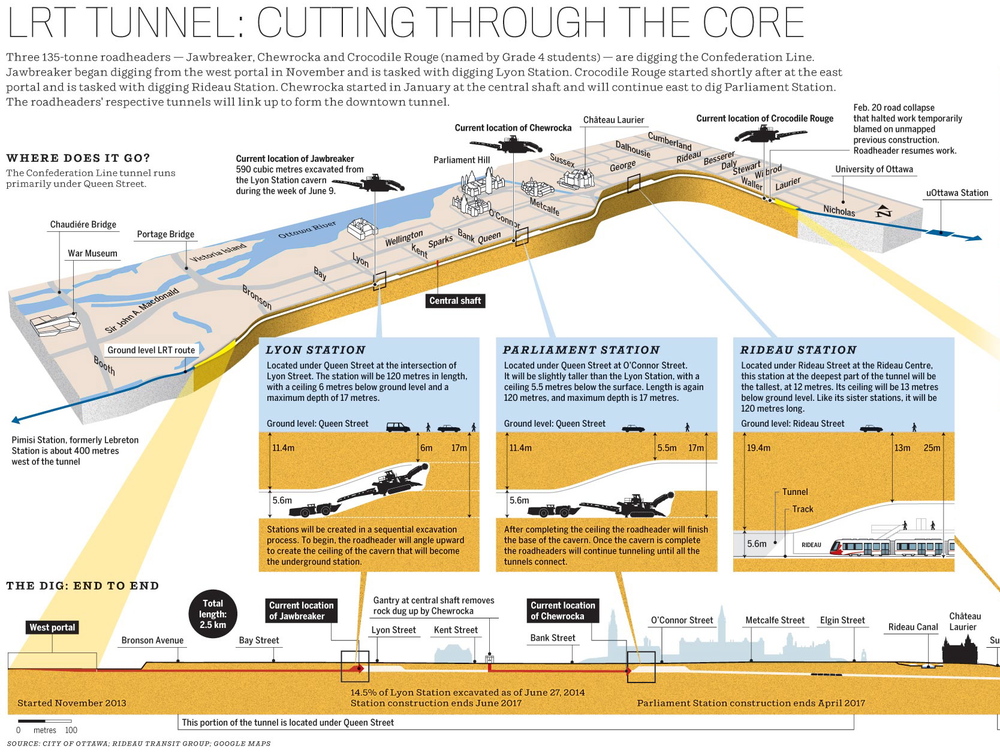LRT Tunnel: Boring beneath Bytown
ROBERT BOSTELAAR, OTTAWA CITIZEN 10.11.2013
OTTAWA — Boring machines? Not for Ottawa’s light-rail project.
We’re talking, to be clear, about tunnel boring machines, aka TBMs or “moles.” TBMs are giant cylinders with spinning-disc faces that rip through substrate like monstrous meat slicers; one of the world’s largest, the 4,000-tonne “Big Becky,” just finished chewing out a 10-kilometre tunnel beneath Niagara Falls to supply more water to the Sir Adam Beck Generating Station.
Boring? You wouldn’t say so if you were in Big Becky’s path.
But the consortium building the LRT line considers TBMs too unwieldy for the 2.5-km Ottawa excavation that it describes as a “short tunnel.” (Relative to such undertakings as the Boston Big Dig, it IS at the lower end of the scale).
So in place of a Big or even Medium-Sized Becky, we get a smaller and more flexible, though still preposing, alternative.
Meet (or maybe hope you don’t) the MT720, a 135-tonne “tunnelling roadheader” produced by Swedish mining and engineering specialist Sandvik AB.
As long and tall as a semi-truck, the MT720 moves on tracks that could have been borrowed from an M1 Abrams battle tank. At its business end is a hydraulically stabilized boom wielding a pair of rotating drums, each bearing more studs than an ’80s punk band.
Formed of sintered carbide tungsten, the studs, or picks, are as hard as sapphire and able to grind through rock with uniaxial compressive strength (UCS) ratings exceeding 120 megapascals. In lay terms, that’s super hard stone. For the Ottawa project, the contractors expect to encounter nothing harder than 78 MPa, and that only in two limestone-and-shale bedrock formations that comprise 26 per cent of the tunnel route.
Debris produced by the cutting drums drops to an apron below and is carried by conveyor to the back of the machine, where it can be loaded in trucks for removal. Trailing behind the assembly is a hawser-thick, 1000-volt cable that carries electricity from a fixed source to the motors powering the grinders, the tracks, the conveyor. The MT720 won’t operate if it’s not plugged in.
Unlike an Abrams tank, Sandvik’s roadheader is designed to advance slowly and then retreat. This allows the tunnellers to immediately secure each short stretch of excavation by inserting bolts far into the walls and coating the newly exposed walls and ceiling with sprayed concrete, known as shotcrete.
To speed the process, the contractors are bringing in three MT720s — one for each end of the tunnel and a third to work from the middle. One has already arrived (in several shipping containers) from New York, where it was used in the $7.3-billion East Side Access project to build rail tunnels from Long Island and Queens to a new station 12 storeys below Manhattan’s Grand Central Terminal. A second MT720, also from the New York project, is expected about Oct. 25, and the third is en route from Austria and should reach Ottawa in mid-November.
Daily, each machine is expected to grind through 200 to 450 cubic metres of rock — just how much will depends on the abrasivity, compressive strength, number of joints and other qualities of the material encountered — while moving forward an average of three metres. So for the whole project, that’s nine metres a day.
The availability of the New York machines may well have been a factor in the decision to use roadheaders. Erik Eberhardt, a professor of geological engineering at the University of British Columbia, says two kilometres is generally viewed as the tunnel length at which TBMs, which dig faster than roadheaders, start to become a more attractive choice. But other considerations, including the type and variety of materials to be excavated and the cost of bringing in equipment, also come into play.
The builders point out that roadheaders can adjust to any excavation shape, a key benefit in an Ottawa project with three underground caverns, or future stations, along its relatively short length. Tunnel boring machines dig at one set diameter, so other equipment must be brought in for any design variation. And the cutting heads be can changed fairly quickly to suit different rock types — again not possible with TBMs.
[...]
/https://www.thestar.com/content/dam/thestar/news/gta/2019/04/15/over-the-don-and-under-fort-york-where-experts-say-building-the-ontario-line-could-get-tricky/queen_and_spadina.jpg)
